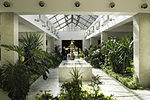Vračar plateau

Vračar Plateau (Serbian: Врачарски плато, romanized: Vračarski plato) is a plateau on top of the Vračar Hill in Belgrade, the capital of Serbia. with an absolute height of 134 metres (440 feet) above sea level. It is the purported location of the 1595 Burning of Saint Sava's relics by the Ottomans. The dominant position in Belgrade's cityscape made the plateau a natural location for the first meteorological observatory in Serbia, Belgrade Meteorological Station, built in 1891. The most distinctive feature of the plateau today is a massive Church of Saint Sava, visible from almost all approaches to the city, and one of the Belgrade's main landmarks. The plateau also houses Karađorđe's Park, Park Milutin Milanković, monument of Karađorđe Petrović and National Library of Serbia. In May 2021, the plateau was protected as the spatial cultural-historical unit under the name Saint Sava's Plateau. The government noted "symbolical, memorial, cultural-historical, architectural-urban and artistic values of the locality, which represents memory spot of two turning points in Serbian history: Burning of Saint Sava's relics and the First Serbian Uprising".
Excerpt from the Wikipedia article Vračar plateau (License: CC BY-SA 3.0, Authors, Images).Vračar plateau
Толстојева, Belgrade Београд (Савски венац) (Savski Venac Urban Municipality)
Geographical coordinates (GPS) Address Nearby Places Show on map
Geographical coordinates (GPS)
| Latitude | Longitude |
|---|---|
| N 44.783333333333 ° | E 20.45 ° |
Address
Толстојева 34
11000 Belgrade, Београд (Савски венац) (Savski Venac Urban Municipality)
Central Serbia, Serbia
Open on Google Maps






